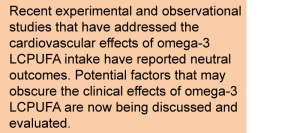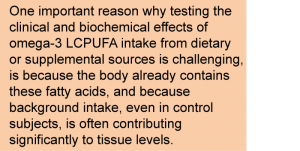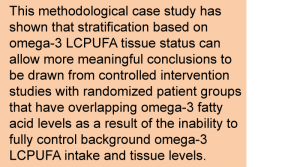Evaluating the Value of Stratification on Omega-3 LCPUFA Levels when the Randomized Controlled Testing Methodology is not Sufficiently Well-Controlled
This article at a glance
- This pilot study evaluated the concept that stratification of study participants can be useful for improving interpretations of the relationship between long-chain polyunsaturated fatty acid (LCPUFA) intake and biological effect.
- In patients scheduled for coronary artery bypass graft and/or heart valve replacement surgery, one group of individuals randomly assigned to receive pre-operative fish oil supplementation displayed largely overlapping erythrocyte membrane omega-3 levels with placebo-treated patients.
- After stratifying the pooled patient groups by high and low omega-3 status, or their omega-3 to omega-6 ratio, statistically significant changes in cardiac tissue responses could be measured.
- The measurement of LCPUFA status of people participating in interventional studies, and control over their background ingestion behaviour, is absolutely required to be able to link study outcomes to dietary or supplemental intake. Stratification of participants based on their fatty acid status can become instrumental in assigning clinical effects to dietary and supplemental intake of LCPUFA.
The outcomes of earlier intervention studies (~1980-2000) on the secondary prevention of cardiovascular disease (CVD), as well as the results from epidemiological studies documenting the effects of omega-3 long-chain polyunsaturated fatty acid (omega-3 LCPUFA) intake from dietary sources over long time periods, had largely supported beneficial effects of eicosapentaenoic acid (EPA) and docosahexaenoic acid (DHA) intake in reducing coronary events, sudden cardiac death, and mortality from cardiovascular disease-related origins. In contrast, several recent prospective cohort studies and randomized controlled intervention trials that have assessed the associations and effects of omega-3 LCPUFA intake with cardiovascular health have reported neutral outcomes. The relatively recent appearance of studies that have been unable to support the conclusions of the earlier studies has stimulated specialists to take a closer look at the factors that may lead to the observation of marginal effects of omega-3 LCPUFA intake on cardiovascular health.
 Several reasons have been proposed to explain the recent lack of an effect of dietary and supplemental omega-3 LCPUFA. These encompass better overall patient care and improved concurrent pharmacotherapy for cardiovascular disease treatment and prevention, treatment periods that are too short, the use of too low doses, small sample sizes, and a background omega-3 intake that has gradually increased over the years, which would have made it harder to raise omega-3 LCPUFA tissue levels as a result of the intervention. Although the systematic evaluation of these factors will take time, it is expected that lessons learned about how to best test the effects of dietary fatty acids in cardiovascular disease will also be illustrative for studies addressing the roles of LCPUFA in organ systems and disorders beyond the cardiovascular system.
Several reasons have been proposed to explain the recent lack of an effect of dietary and supplemental omega-3 LCPUFA. These encompass better overall patient care and improved concurrent pharmacotherapy for cardiovascular disease treatment and prevention, treatment periods that are too short, the use of too low doses, small sample sizes, and a background omega-3 intake that has gradually increased over the years, which would have made it harder to raise omega-3 LCPUFA tissue levels as a result of the intervention. Although the systematic evaluation of these factors will take time, it is expected that lessons learned about how to best test the effects of dietary fatty acids in cardiovascular disease will also be illustrative for studies addressing the roles of LCPUFA in organ systems and disorders beyond the cardiovascular system.
Another important aspect to take into account when using a randomized controlled intervention to study the clinical effects of omega-3 LCPUFA intake is that investigators should carefully consider the dose at which a specific response can be expected, based on previous data. Otherwise, they risk using a dose that is unlikely to be sufficient to demonstrate any changes in response. The dose-response relationships for EPA+DHA intake for different aspects of cardiovascular disease have been estimated, and show for example that a linear dose-dependent reduction in arrhythmia development occurs up to a daily dose of 250 mg. Blood pressure-lowering and heart rate-lowering occurs over a much wider dose range, up to several grams a day, in a non-linear fashion, and triglyceride-lowering occurs in a linear fashion up to 2.5 g a day. The anti-thrombotic effect of EPA/DHA does not become apparent up to 2.5 g a day. Additionally, tissue content of DHA, as measured by the content in erythrocyte membranes, relates to the risk of post-operative atrial fibrillation in a U-shaped fashion. Also, the time needed to achieve these effects differs, ranging from daily dosing for several weeks, to sustained intake for years.
Another important factor to consider is the use of composite primary endpoints to test the efficacy of omega-3 LCPUFA. Composite end-points are frequently used, given the practical challenge of enrolling a sufficient number of participants to achieve sufficient power to detect changes in a primary outcome. However, this approach can obscure the true efficacy of a particular daily dose of omega-3 LCPUFA on one of the aspects that form part of the composite, if at that dose the other endpoints fall outside a dose range where a change in response can be observed.
In addition to the above-mentioned challenges that may obscure the detection of omega-3 LCPUFA intake-induced effects, it is important to note that the body and most tissues already contain omega-3 LCPUFA, therefore studies should consider the background diet and tissue levels of LCPUFA. A premise of a randomized controlled clinical trial for a drug is that the background tissue level of the test substance and its metabolites are absent. Furthermore, placebo treatment should not contribute to the introduction of the test substance. However, it has been shown that background omega-3 LCPUFA intake in participants in both control and active treatment groups can be of sufficient magnitude to bring tissue omega-3 LCPUFA levels to the same level as achieved in the active treatment group. In addition, the incorporation of EPA and DHA following dietary or supplemental intake demonstrates a marked inter-individual variability. Thus, summarising the challenges to improve experimental study design for evaluating the relevance of omega-3 LCPUFA intake for human health, there exists an absolute need to measure the tissue status of omega-3 LCPUFA in study participants, at study onset, during the study and at study end. Background intake should be carefully controlled, should ideally be nil (no fish intake or supplements during the study), and should be reported.
 Atrial fibrillation is a serious and frequently-occurring complication of cardiac surgery. Post-operative atrial fibrillation is usually addressed by rhythm- or rate-management, which aims to restore a normal sinus rhythm. Relatively short-term pre-operative supplementation with omega-3 LCPUFA prior to scheduled cardiac surgery has been shown to improve surgical outcomes, but the results of studies that aim to evaluate the potential use of omega-3 LCPUFA as a preventive approach to lower atrial fibrillation have been highly variable. In one study, patients scheduled for coronary bypass artery grafting or heart valve replacement and receiving three weeks of EPA/DHA prior to surgical intervention, had significantly increased mean levels of omega-3 LCPUFA compared to individuals receiving a placebo not containing omega-3 LCPUFA. The mean length of hospital stay decreased, whereas post-operative atrial fibrillation incidence was not significantly changed. When the omega-3 LCPUFA levels in erythrocytes were looked at in detail, it was found that approximately half of the patients receiving placebo for three weeks had omega-3 levels that were overlapping with the levels of half of the participants of the study group that had received omega-3 LCPUFA. The level of EPA and DHA is ideally measured in atrial tissue, or if samples from this tissue are not accessible, erythrocyte EPA and DHA levels can be determined, given the good correlation between levels of LCPUFA in the two compartments.
Atrial fibrillation is a serious and frequently-occurring complication of cardiac surgery. Post-operative atrial fibrillation is usually addressed by rhythm- or rate-management, which aims to restore a normal sinus rhythm. Relatively short-term pre-operative supplementation with omega-3 LCPUFA prior to scheduled cardiac surgery has been shown to improve surgical outcomes, but the results of studies that aim to evaluate the potential use of omega-3 LCPUFA as a preventive approach to lower atrial fibrillation have been highly variable. In one study, patients scheduled for coronary bypass artery grafting or heart valve replacement and receiving three weeks of EPA/DHA prior to surgical intervention, had significantly increased mean levels of omega-3 LCPUFA compared to individuals receiving a placebo not containing omega-3 LCPUFA. The mean length of hospital stay decreased, whereas post-operative atrial fibrillation incidence was not significantly changed. When the omega-3 LCPUFA levels in erythrocytes were looked at in detail, it was found that approximately half of the patients receiving placebo for three weeks had omega-3 levels that were overlapping with the levels of half of the participants of the study group that had received omega-3 LCPUFA. The level of EPA and DHA is ideally measured in atrial tissue, or if samples from this tissue are not accessible, erythrocyte EPA and DHA levels can be determined, given the good correlation between levels of LCPUFA in the two compartments.
 In effect, the observations suggested that the two groups were not following expectations – a very substantial section of the participants in the treatment and control groups were not different from each other. Furthermore, participants that had been randomly assigned to the control group, but that reported eating fish, were separated from the control group and were allowed to continue eating fish and take omega-3 supplements. This special observation group had, after three weeks, omega-3 fatty acid levels that were indistinguishable from the treatment group. This means that participants in both control and treatment groups need to be followed closely during any intervention, and instructed not to ingest any fish or take supplements. Inter-individual omega-3 fatty acid blood and tissue levels vary considerably, due to environmental and genetic effects, and their incorporation into tissues is highly variable following dietary or supplemental intake. As another example, in a study with pregnant women, DHA supplementation from week 16 to 36 of gestation led to a mean increase in erythrocyte membrane DHA, but again a significant number of individuals in the placebo group had as good DHA levels as those in the treatment group.
In effect, the observations suggested that the two groups were not following expectations – a very substantial section of the participants in the treatment and control groups were not different from each other. Furthermore, participants that had been randomly assigned to the control group, but that reported eating fish, were separated from the control group and were allowed to continue eating fish and take omega-3 supplements. This special observation group had, after three weeks, omega-3 fatty acid levels that were indistinguishable from the treatment group. This means that participants in both control and treatment groups need to be followed closely during any intervention, and instructed not to ingest any fish or take supplements. Inter-individual omega-3 fatty acid blood and tissue levels vary considerably, due to environmental and genetic effects, and their incorporation into tissues is highly variable following dietary or supplemental intake. As another example, in a study with pregnant women, DHA supplementation from week 16 to 36 of gestation led to a mean increase in erythrocyte membrane DHA, but again a significant number of individuals in the placebo group had as good DHA levels as those in the treatment group.
Without testing omega-3 LCPUFA status and rigorously controlling the background omega-3 LCPUFA dietary intake, many studies have been carried out and others are likely in progress, without any knowledge whether the study groups are in fact different. Following the awareness of these general and omega-3 LCPUFA-specific study design limitations, a post-hoc regression analysis that determines the relationships between tissue levels of omega-3 LCPUFA and outcomes was recently suggested to be a potentially useful approach. However, a formal demonstration that such an approach has any value, has not been made.
To test the possibility that clinically-relevant effects may be detectable after stratifying patients based on their omega-3 LCPUFA status, Ip and colleagues recently carried out a pilot study with twenty patients that were scheduled to undergo coronary artery bypass graft (CABG) surgery or heart valve repair or replacement. The research was carried out at the Rheumatology Unit at the Royal Adelaide Hospital, and the Disciplines of Medicine and Public Health, at the University of Adelaide, in Australia. EPA/DHA ingestion and tissue incorporation in this study was measured as the percentage of EPA plus DHA of total fatty acids in erythrocyte membranes (i.e. the omega-3 index). Only patients showing a stable sinus rhythm at pre-admission inspection were included in this study. Patients were randomly assigned to one of two study groups of ten people each. The average age of the study participants was 64 years. The treatment group received three capsules of tuna oil per day during the pre-surgical period, providing a daily intake of 1.1 g EPA and DHA combined. Patients in the placebo group received three capsules containing high-oleic sunflower oil daily. The daily supplementation lasted for an average period of 14.5 and 11.5 days prior to surgery, in the treatment and control groups, respectively.
At surgery, venous blood was collected and used for the analysis of erythrocyte membrane lipids. Biopsies were taken from the right atrial appendage, and used for the determination of the gene and protein expression of several proteins responsive to surgery-induced ischaemia and involved in tissue-protective pathways. The incidence of post-operative atrial fibrillation was determined from electrocardiogram records, and scored as present or absent.
The mean age of the patients in the placebo and fish oil groups was similar, 67 ± 3 and 61 ± 4 years, respectively. No significant differences were reported between the groups with respect to gender (80 and 70% male, respectively), the length of the treatment period up to the day of surgery, and the occurrence of post-surgical atrial fibrillation (50 and 30%, respectively). No differences were observed in the gene expression in the myocardium of the apoptosis-related proteins Bax and Bcl2, or the transcription factor PPARα. There were no differences in protein expression in Bax, Bcl2 or phospho-Akt (the activated form of Akt, a kinase involved in cell proliferation and signal transduction) between the two patient groups. No associations between the level of EPA and DHA in erythrocyte membranes and the duration of treatment or patient age were found.
 An extensive overlap in the levels of EPA and DHA in erythrocyte membranes between the patients of the two groups was observed. The authors next examined the associations between EPA and DHA levels and clinical markers in the pooled cohort of control and treated patients. Several associations were evident between the level of EPA, DHA or both fatty acids together, and gene and protein expression of the tested atrial myocardial markers. DHA content in erythrocyte membranes was significantly and negatively correlated with the gene expression of PPARα, and with the ratio of Bcl2 to Bax gene expression.
An extensive overlap in the levels of EPA and DHA in erythrocyte membranes between the patients of the two groups was observed. The authors next examined the associations between EPA and DHA levels and clinical markers in the pooled cohort of control and treated patients. Several associations were evident between the level of EPA, DHA or both fatty acids together, and gene and protein expression of the tested atrial myocardial markers. DHA content in erythrocyte membranes was significantly and negatively correlated with the gene expression of PPARα, and with the ratio of Bcl2 to Bax gene expression.
The finding of significant associations in the entire pooled patient cohort that could not be distinguished as effects between the randomly generated groups pointed to the need to better stratify the participants of this intervention trial. It has been proposed that robust differences in the clinical outcome of chronic cardiovascular disease-associated illness can be appreciated at a threshold level of >8% EPA plus DHA in erythrocyte membranes. Upon stratification, 44% of fish oil-treated patients were reassigned to the below threshold level, whereas 20% of control patients were located above the threshold. After stratification, 12 patients fell below the threshold, with an average omega-3 index of ~7.1%, whereas the remaining patients above the threshold had an average index of ~8.4%. A significantly lower omega-6 to omega-3 ratio was also observed after stratification. Much smaller differences in average omega-3 index or omega-6 to omega-3 ratios were seen in the randomized groups, indicating that stratification can provide enhanced sensitivity to distinguish groups of patients based on fatty acid levels.
The value of stratification by omega-3 LCPUFA membrane incorporation became evident when the expression of the myocardial surrogate markers for atrial tissue activation and risk of cardiac arrest were re-evaluated. In contrast to the randomized groups, the status of patients above the 8% threshold displayed a significantly lower expression of PPARα. Stratification did not modify the Bcl2 to Bax or p-Akt to total Akt protein expression ratios. Atrial fibrillation incidence was marginally lower in the stratified group with an omega-3 index >8% compared to what was observed in the randomized fish oil-treated group, but any changes in atrial fibrillation incidence in both the randomized and stratified groups were not statistically significant.
 This study has provided a clear example that in a randomized placebo-controlled and double-blind intervention study, a large proportion of patients who had received fish oil as a source of omega-3 LCPFA did not have erythrocyte omega-3 levels higher than those in the placebo group. Likewise, one out of five placebo-controlled patients had such a good omega-3 status that they exceeded a >8% EPA plus DHA threshold associated with a low risk cardiovascular disease profile. This study, although small, has shown the effectiveness of randomizing patients to produce clearly distinguishable treatment groups, for which a treatment effect could be tested by measurement of a marker of omega-3 LCPUFA ingestion. The authors indicate that this pilot study did not have enough power to demonstrate that a reduction in post-operative atrial fibrillation may have occurred. Stratification when applied to a larger study population promises to provide a definitive answer to the long-standing question whether increased pre-operative dietary or supplemental intake has an impact on post-operative atrial fibrillation.
This study has provided a clear example that in a randomized placebo-controlled and double-blind intervention study, a large proportion of patients who had received fish oil as a source of omega-3 LCPFA did not have erythrocyte omega-3 levels higher than those in the placebo group. Likewise, one out of five placebo-controlled patients had such a good omega-3 status that they exceeded a >8% EPA plus DHA threshold associated with a low risk cardiovascular disease profile. This study, although small, has shown the effectiveness of randomizing patients to produce clearly distinguishable treatment groups, for which a treatment effect could be tested by measurement of a marker of omega-3 LCPUFA ingestion. The authors indicate that this pilot study did not have enough power to demonstrate that a reduction in post-operative atrial fibrillation may have occurred. Stratification when applied to a larger study population promises to provide a definitive answer to the long-standing question whether increased pre-operative dietary or supplemental intake has an impact on post-operative atrial fibrillation.
The authors also provide suggestions for future studies, notably that regular fish consumption and study entry erythrocyte lipid composition should be documented, in order to make decisions on the design of treatment groups that, for example, have a clearly defined or contrasted LCPUFA background. In addition, participants with a low omega-3 index, or low omega-3 to omega-6 ratio, should ideally be recruited when participants are treated towards a pre-specified target omega-3 index range, for example 8-11%, or they should be treated with multiple doses to gain information on non-linear responses. This study was not carried out on patients that had a very poor omega-3 profile. The average omega-3 index in the placebo group, which would be reflective of background intake (on the premise that patients did not markedly adjust their dietary behavior prior to cardiac surgery), was about 7.3%.
Now that the power of post-hoc stratification on omega-3 index, or on the tissue omega-3 to omega-6 LCPUFA relationship has been demonstrated, future studies with more participants will be interesting to carry out. Such intervention studies are likely to provide clearer answers whether dietary intake or supplementation with omega-3 LCPUFA influence clinical outcomes, for which study approaches involving randomization alone, and without knowledge of LCPUFA status, are clearly limiting and obscuring individual clinical responses.
Ip WT, Chandramouli C, Smith JA, McLennan PL, Pepe S, Delbridge LM. A small cohort omega-3 PUFA supplement study: Implications of stratifying according to lipid membrane incorporation in cardiac surgical patients. Heart Lung Circ. 2017. [PubMed]
Worth Noting
Atlas of human cardiac anatomy: http://www.vhlab.umn.edu/atlas/right-atrium/index.shtml
Bowen KJ, Harris WS, Kris-Etherton PM. Omega-3 fatty acids and cardiovascular disease: Are there benefits? Curr. Treat. Options Cardiovasc. Med. 2016;18(11):69. [PubMed]
Farquharson AL, Metcalf RG, Sanders P, Stuklis R, Edwards JR, Gibson RA, Cleland LG, Sullivan TR, James MJ, Young GD. Effect of dietary fish oil on atrial fibrillation after cardiac surgery. Am. J. Cardiol. 2011;108(6):851-856. [PubMed]
Innis SM, Friesen RW. Essential n-3 fatty acids in pregnant women and early visual acuity maturation in term infants. Am. J. Clin. Nutr. 2008;87(3):548-557. [PubMed]
James MJ, Sullivan TR, Metcalf RG, Cleland LG. Pitfalls in the use of randomised controlled trials for fish oil studies with cardiac patients. Br. J. Nutr. 2014;112(5):812-820. [PubMed]
Metcalf RG, Cleland LG, Gibson RA, Roberts-Thomson KC, Edwards JR, Sanders P, Stuklis R, James MJ, Young GD. Relation between blood and atrial fatty acids in patients undergoing cardiac bypass surgery. Am. J. Clin. Nutr. 2010;91(3):528-534. [PubMed]
Mozaffarian D, Rimm EB. Fish intake, contaminants, and human health: evaluating the risks and the benefits. JAMA 2006;296(15):1885-1899. [PubMed]
Sigurdsson MI, Body SC. Rhythm is a dancer: the immediate management of postoperative atrial fibrillation following cardiac surgery. Ann. Transl. Med. 2016;4(Suppl 1):S32. [PubMed]
Superko HR, Superko SM, Nasir K, Agatston A, Garrett BC. Omega-3 fatty acid blood levels: clinical significance and controversy. Circulation 2013;128(19):2154-2161. [PubMed]
von Schacky C. Omega-3 index and cardiovascular health. Nutrients 2014;6(2):799-814. [PubMed]

